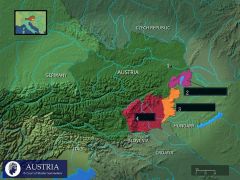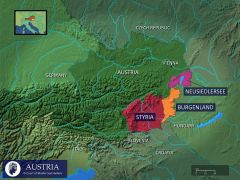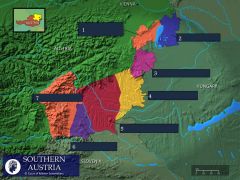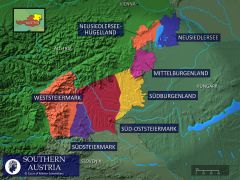![]()
![]()
![]()
Use LEFT and RIGHT arrow keys to navigate between flashcards;
Use UP and DOWN arrow keys to flip the card;
H to show hint;
A reads text to speech;
35 Cards in this Set
- Front
- Back
|
Regions of Austria
Weinbaugebiete |
Weinland:
Steierland: Bergland: |
|
|
Weinland Regions
|
Burgenland
Niederösterreich Wien |
|
|
Steierland Regions
|
Steiermark
|
|
|
Bergland Regions
|
Vorarlberg (12 ha in 2012)
Tirol (8 ha in 2012) Salzburg (2 ha in 2012) Oberösterreich (15 ha in 2012) Kärnten (50 ha in 2012) |
|
|
Subregions of Burgenland
|
Eisenberg DAC
Leithaberg DAC Mittelburgenland DAC Neusiedlersee DAC Neusiedlersee-Hügelland Südburgenland |
|
|
Eisenberg DAC
|
•Region: Burgenland (Südburgenland)
•Major Villages: Eisenberg, Deutsch Schützen, Rechnitz •Grape Varieties: Blaufränkisch •Minimum/Maximum Alcohol: ◦Classic: 12% ◦Reserve: 13% (no specified max.) Maximum Residual Sugar (DAC Wines): 4 g/l •Aging Requirements: ◦Classic: May be released from September 1 of the year following the harvest ◦Reserve: May be released from March 1 of the second year following the harvest (must be aged in wood) •Soil Type: gravel and slate •First Vintage: 2009 (2008 for Reserve |
|
|
Leithaberg DAC
|
•Region: Burgenland (Neusiedlersee-Hügelland)
•Major Villages: Eisenstadt, Jois, Winden, Breitenbrunn, Purbach, Donnerskirchen, Schützen •Grape Varieties: ◦White: Grüner Veltliner, Neuburger, Chardonnay, Weissburgunder (blends or single varietals) ◦Red: Blaufränkisch, plus a max. 15% combined Pinot Noir, St. Laurent, and Zweigelt Maximum Residual Sugar (DAC Wines): 2.5 g/l •Minimum/Maximum Alcohol: 12.5%/13.5% •Soil Type: gneiss, mica-slate, and limestone (Leithakalk) •First Vintage: 2009 is the first white vintage, 2008 is the first red vintage |
|
|
Mittelburgenland DAC
|
•Region: Burgenland
•Major Villages: Deutschkreutz, Horitschon, Lutzmannsburg, Neckenmarkt •Grape Varieties: Blaufränkisch •Minimum/Maximum Alcohol: ◦Classic: 12.5%/13% ◦Classic with Specified Site: 13%/13.5% ◦Reserve: 13% (no specified max.) Maximum Residual Sugar (DAC Wines): 2.5 g/l •Aging Requirements: ◦Classic: May be released from March 1 of the year following the harvest (large casks or stainless steel must be used for aging) ◦Classic with Specified Site: May be released from March 1 of the year following the harvest (large casks, stainless steel or used barriques may be used for aging) ◦Reserve: May be released from March 1 of the second year following the harvest (large casks, new or used barriques may be used for aging) •Soil Type: Deep clay •First Vintage: 2005 |
|
|
Neusiedlersee DAC
|
•Region: Burgenland
•Approximate Total Hectares Under Vine (2010): 7,649 ha (prior to DAC) •Major Villages: Gols, Mönchhof, Halbturn, Podersdorf, Frauenkirchen, Illmitz, Apetlon, Andau •Grape Varieties: ◦Min. 60% Zweigelt ◦Max. 40% Indigenous Red Varieties •Minimum Alcohol: ◦Classic: 12% ◦Reserve: 13% •Minimum Aging: ◦Classic: Wines may be released on March 1 of the year following the harvest. ◦Reserve: Wines may be released on March 1 of the second year following the harvest. Maximum Residual Sugar (DAC Wines): 4 g/l •Soil Type: •First Vintage (DAC): 2011 (Reserve from 2010 vintage |
|
|
Neusiedlersee-Hügelland
|
•Region: Burgenland
•DAC Subregions: Leithaberg DAC •Approximate Total Hectares Under Vine (2010): 3,576 ha •Major Villages: Jois, Winden, Purbach, Donnerskirchen, Schützen, Oggau, Rust, Mörbisch, Grosshöflein •Principle Grape Varieties: ◦White (2,308 ha in 2008): Grüner Veltliner, Welschriesling, Weissburgunder, Chardonnay, Müller Thurgau, Neuburger, Muskat Ottonel ◦Red (1,802 ha in 2008): Blaufränkisch, Zweigelt, Pinot Noir, Cabernet Sauvignon, Merlot •Soil Type: granite, chalk and limestone |
|
|
Südburgenland
|
•Region: Burgenland
•DAC Subregions: Eisenberg DAC •Approximate Total Hectares Under Vine (2010): 498 ha •Major Villages: Eisenberg, Deutsch Schützen, Rechnitz, Heiligenbrunn, Moschendorf •Principle Grape Varieties: ◦White (259 ha in 2008): Welschriesling, Grüner Veltliner ◦Red (267 ha in 2008): Blaufränkisch, Zweigelt •Soil Type: iron-rich soils |
|
|
Subregions of Niederösterreich
|
Wachau
Kremstal DAC Kamptal DAC Traisental DAC Wagram Weinviertel DAC Carnuntum Thermenregion |
|
|
Wachau
|
•Region: Niederösterreich
•Approximate Total Hectares Under Vine (2010): 1,350 ha •Major Villages and Vineyards: ◦Spitz: Axpoint, Rotes Tor ◦Weissenkirchen: Achleiten, Hinter der Burg, Hinter Sieber ◦Wösendorf: Kollmütz, Hochrain ◦Joching: Stein am Rain, Pichlpoint, Kollmitz, Postaller ◦Dürnstein: Hollerin, Kellerberg, Höhereck ◦Unterloiben/Oberloiben: Loiben Berg, Mühlpoint, Klostersatz, Steinertal ◦Mautern •Principal Grape Varieties: ◦White (1,263 ha in 2008): Grüner Veltliner, Riesling, Müller Thurgau, Neuburger, Weissburgunder, Chardonnay ◦Red (165 ha in 2008): Zweigelt, St. Laurent, Blauer Portugieser •Soil Type: loess and gneiss (gföhler) Key Producers: Emmerich Knoll, Franz Hirtzberger, Rudi Pichler, FX Pichler, Prager |
|
|
Wachau Soil Structure and Natural Features
|
The vineyards of the Wachau line terraces along the Danube (Donau) River. Lower, east-facing vineyards typically contain sandy loess soils, whereas the steeper, higher vineyards (450 meters and above) are characterized by shallow soils and a higher proportion of the underlying Gföhl gneiss and other primary rock.
|
|
|
Vinea Wachau "Codex Wachau"
|
•Classification: ◦Steinfeder: max. 11.5% abv; min 15 KMW
◦Federspiel: 11.5-12.5% abv; min 17 KMW ◦Smaragd: min. 12.5% abv; min 19 KMW •Origin: Vineau Wachau wines must be composed solely of grapes grown in Wachau and the wines must be bottled in Wachau •No Additives: Chaptalization and any form of must concentrate are prohibited •No Concentration: The natural composition of the wine or must cannot be altered (by means such as reverse osmosis, cryo-extraction, etc.) •No Aromatization: The natural aromatic qualities of the wine may not be altered (significantly, this precludes the use of barriques and wood chips) •No Fractionation: Spinning cone devices and similar means are prohibited •No Manipulation of Nature: A broader renunciation of any "unnatural" practices, including a requirement that all harvests must be conducted by hand |
|
|
Kremstal DAC
|
•Region: Niederösterreich
•Major Villages: Krems, Senftenberg, Rohrendorf, Gedersdorf, Furth •Grape Varieties: ◦Grüner Veltliner: "fresh, fruit-accented, fine spiciness; no Botrytis note; no wood tone" ◦Riesling: "fragrant, stone fruit aromas, elegant, minerally; no Botrytis note; no wood tone" ◦New barrique and hints of botrytis are allowed at the Reserve level Maximum Residual Sugar (DAC Wines): Wines must be legally trocken (9 g/l, provided total acidity is within 2 g/l of residual sugar) •Minimum Alcohol: ◦Classic: 12% ◦Reserve: 13% •Soil Type: weathered primary rock toward Wachau and loess toward Kamptal •First Vintage: 2007 Key Producers: Stadt Krems, Nigl |
|
|
Kremstal Soil Structure and Natural Features
|
The Danube (Donau) and Krems Rivers (a Danube tributary) flow through the heart of the DAC.
East of the Krems River, soil structures include deep loess terraces, whereas those to the west have shallower soils and more primary rock. |
|
|
Kremstal DAC
2012 Traditionsweingüter Österreich Erste Lage (listed by village): 31 total |
◦Angern: Gaisberg
◦Furth: Gottschelle, Oberfeld, Silberbichl ◦Gedersdorf: Mosburgerin, Spiegel, Steingraben, Vordernberg, Wieland ◦Hollenberg/Krems: Goldberg ◦Krems: Frechau, Gebling, Grillenparz, Kapuzinerberg, Lindberg, Thurnerberg, Wachtberg ◦Oberfucha/Furth: Kirchensteig, Steinleithn ◦Palt: Steinbuhel ◦Rohrendorf: Breiter Rain, Gebling, Schnabel ◦Senftenberg: Ehrenfels, Hochäcker, Pellingen, Pfeningberg ◦Stein: Gaisberg, Kögl, Pfaffenberg ◦Stratzing: Sunogeln |
|
|
Kamptal DAC
|
•Region: Niederösterreich
•Major Villages: Langenlois, Zöbing, Kammern, Gobelsburg, Strass im Strassertal, Haindorf, Lengenfeld, Schönberg •Grape Varieties: ◦Grüner Veltliner: "fresh, fruit-accented, fine spiciness; no Botrytis note; no wood tone" ◦Riesling: "fragrant, stone fruit aromas, elegant, minerally; no dominant Botrytis note; no wood tone" ◦New barrique and hints of botrytis are allowed at the Reserve level. Maximum Residual Sugar (DAC Wines): Wines must be legally trocken (9 g/l, provided total acidity is within 2 g/l of residual sugar). •Minimum Alcohol: ◦Classic: 12% ◦Reserve: 13% •Soil Type: loess and loam soils near the Danube, volcanic soils, and sandstone (in the Heiligenstein vineyard) •First Vintage: 2008 Key Producers: Schloss Gobelsberg, Bründlmayer, Brandl, Hirsch, Hiedler |
|
|
Kamptal Soil Structure and Natural Features
|
Kamptal soils are variable, and include loess, clay and loam. Loess and clay-loam are prevalent nearer the Danube River, whereas the higher, steeper vineyards have thin topsoil and more primary rock, like Gföhl gneiss and mica-schist. In the Heiligenstein vineyard, there is a rare outcropping of weathered sandstone, mixed with volcanic rock.
The Kamp River, a tributary of the Danube, flows through the heart of the DAC. |
|
|
Kamptal DAC
2012 Traditionsweingüter Österreich Erste Lage (listed by village): 21 total |
• ◦Engabrunner: Stein
◦Kammern: Gaisberg, Grub, Lamm, Renner ◦Langenlois: Dechant, Käferberg, Kittmannsberg, Loiserberg, Schenkenbichl, Seeberg, Spiegel, Steinhaus, Steinmassl, Thal ◦Strass im Strassertal: Gaisberg, Ofenberg, Wechselberg Spiegel ◦Zöbing: Gaisberg, Kogelberg, Heiligenstein |
|
|
Traisental DAC
|
•Region: Niederösterreich
•Major Villages: Nussdorf, Reichersdorf, Inzersdorf, Traismauer, Herzogenburg •Grape Varieties: ◦Grüner Veltliner: "fresh, fruity, spicy; no Botrytis note; no wood tone" ◦Riesling: "robust, good body, aromatic, minerally; no Botrytis note; no wood tone" Maximum Residual Sugar (DAC Wines): "trocken" (9 g/l, provided total acidity is within 2 g/l of residual sugar •Minimum Alcohol: ◦Classic: 12% ◦Reserve: 13% •Soil Type: Limestone and gravel •First Vintage: 2006 Key Producers: Markus Huber, Ludwig Neumayer |
|
|
Traisental DAC
•2012 Traditionsweingüter Österreich Erste Lage (listed by village) |
◦Getzersdorf: Berg
◦Inzersdorf-Getzersdorf: Rothenbart, Zwirch ◦Reichersdorf: Alte Setzen |
|
|
Wagram
|
•Region: Niederösterreich
•Approximate Total Hectares Under Vine (2010): 2,451 ha •Major Villages: Feuersbrunn, Fels, Grossriedenthal, Gösing, Kirchberg, Grossweikersdorf, Klosterneuburg •2012 Traditionsweingüter Österreich Erste Lage (listed by village): 6 total ◦Fels am Wagram: Brunnthal, Scheiben ◦Feuersbrunn: Rosenberg, Spiegel ◦Kirchberg: Schlossberg ◦Grossweikersdorf: Mordthal •Principal Grape Varieties: ◦White (2,266 ha in 2008): Grüner Veltliner, Müller Thurgau, Weissburgunder, Chardonnay, Riesling, Roter Veltliner ◦Red (591 ha in 2008): Zweigelt, Blauer Portugieser, Blauburger, Pinot Noir •Soil Type: loess Key Producers: Stift Klosterneuburg, Bernhard Ott, Wimmer-Czerny, Leth |
|
|
Wienviertel DAC
|
•Region: Niederösterreich
•Major Villages: Hohenwart, Röschitz, Retz, Falkenstein, Poysdorf, Zistersdorf, Mannersdorf, Wolkersdorf •Grape Varieties: ◦Grüner Veltliner: " fruity, spicy, peppery; no Botrytis note; no wood tone" ◦For Reserve GV, "subtle botrytis and wood notes are acceptable •Minimum Alcohol: ◦Classic: 12% ◦Reserve: 13% •Soil Type: varied •First Vintage: 2002 (Reserve category introduced for the 2009 vintage) Key Producers: Weingut R&A Pfaffl, |
|
|
Carnuntum
|
•Region: Niederösterreich
•Approximate Total Hectares Under Vine (2010): 910 ha •Major Villages: Göttlesbrunn, Arbesthal, Höflein, Petronell, Prellenkirchen •Principal Grape Varieties: ◦White (536 ha in 2008): Grüner Veltliner, Welschriesling, Weissburgunder, Chardonnay, Müller Thurgau ◦Red (496 ha in 2008): Zweigelt, Blaufränkisch, Merlot, Blauburger •Soil Type: stony loam and loess Producers: Muhr-van der Niepoort, Gerhard Markowitsch, Glatzer |
|
|
Thermenregion
|
•Region: Niederösterreich
•Approximate Total Hectares Under Vine (2010): 2,196 ha •Major Villages: Gumpoldskirchen, Traiskirchen, Pfaffstätten, Baden, Sooss, Bad Vöslau, Tattendorf •Principal Grape Varieties: ◦White (1,422 ha in 2008): Neuburger, Weissburgunder, Chardonnay, Grüner Veltliner, Rotgipfler, Riesling, Welschriesling, Zierfandler, Müller Thurgau, Frühroter Veltliner ◦Red (1,092 ha in 2008): Blauer Portugieser, Zweigelt, St. Laurent, Pinot Noir, Blauburger, Cabernet Sauvignon •Soil Type: clay, sandy loam and brown earth Producers: Johanneshof Reinisch |
|
|
Wien
|
•Region: Wien
•Approximate Total Hectares Under Vine (2010): 612 ha •Major Vineyards: Bisamberg, Nussberg, Kahlenberg, Georgenberg •Principal Grape Varieties: ◦White (538 ha in 2008): Grüner Veltliner, Riesling, Weissburgunder, Chardonnay, Welschriesling, Müller Thurgau ◦Red (114 ha in 2008): Zweigelt, Pinot Noir, Blauburger |
|
|
Wiener Gemischter Satz DAC
|
Region: Wien (Vienna)
Grape Varieties: Wines must be a blend of at least 3 white varieties. No single variety may compose more than 50% of the blend, and 3 varieties must make up at least 10% each. Minimum Alcohol: Wines with geographic indication "Wien": max. 12.5% Single Vineyard Wines: min. 12.5% Other Requirements: Wines with geographic indication "Wiener" may not show obvious wood tones and must be trocken in style. Single Vineyard wines may not be released prior to March 1 of the year following the harvest, and are not required to be trocken. First DAC Vintage: 2013 |
|
|
Subregions of Steiermark (Styria)
|
Südsteiermark
Südoststeiermark Weststeiermark |
|
|
Südoststeiermark
|
•Region: Steiermark (Styria)
•Approximate Total Hectares Under Vine (2010): 1,400 ha •Major Villages: Hartberg, Fürstenfeld, Kapfenstein, St. Anna am Aigen, Klöch, Straden, Bad Gleichenberg •Principal Grape Varieties: ◦White (1,080 ha in 2008): Welschriesling, Weissburgunder, Chardonnay, Müller Thurgau, Scheurebe, Sauvignon Blanc, Goldburger, Traminer, Riesling, Pinot Gris, Muskateller ◦Red (296 ha in 2008): Zweigelt, Blauer Wildbacher •Soil Type: volcanic basalt, sand, loam, and weathered primary rock soils Producers: Weingut Tement, Polz |
|
|
Südsteiermark
|
•Region: Steiermark (Styria)
•Approximate Total Hectares Under Vine (2010): 2,340 ha •Major Villages: Gamlitz, Ratsch, Berghausen, Spielfeld, Leutschach, Kitzeck •Principal Grape Varieties: ◦White (1,789 ha in 2008): Weissburgunder, Chardonnay, Welschriesling, Sauvignon Blanc, Müller Thurgau, Muskateller ◦Red (314 ha in 2008): Zweigelt, Blauer Wildbacher •Soil Type: various (sandstone, slate, marl, limestone) |
|
|
Weststeiermark
|
•Region: Steiermark (Styria)
•Approximate Total Hectares Under Vine (2010): 500 ha •Major Villages: Stainz, St. Stefan ob Stainz, Deutschlandsberg •Principal Grape Varieties: ◦White (106 ha in 2008): Weissburgunder, Chardonnay, Welschriesling, Sauvignon Blanc, Müller Thurgau ◦Red (377 ha in 2008): Blauer Wildbacher •Soil Type: gneiss, schist and sedimentary rock |
|

|

|
|

|

|

